The best way to store weed
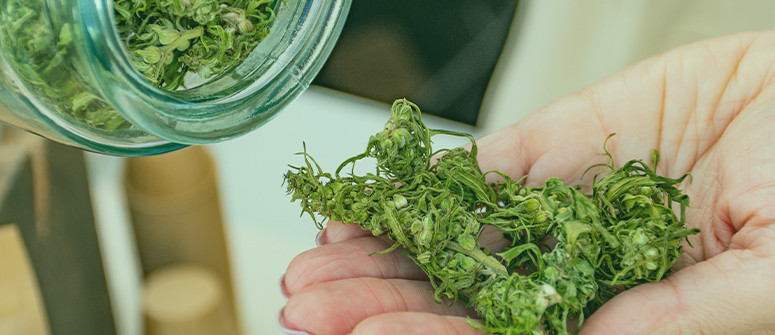
Weed needs to be stored correctly to avoid going dry and stale. Check out our pro tips on storing your weed for optimal freshness, as well as some tips on what to avoid.
Contents:
It's been a long, hard day, but the thought of smoking fresh, THC-rich buds is keeping you going. However, those buds won't stay fresh for long, especially if you leave them exposed to the elements. The good news is we can help you keep your buds fresher for longer, ensuring you never have to come home to dried-up, dusty nugs.
Why should you store weed correctly?
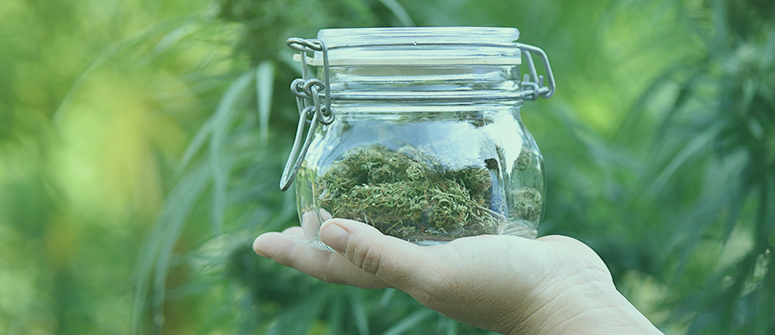
Whether you've taken the time to grow them yourself or spend hard-earned money buying buds from a local dispensary or coffeeshop, nobody wants their most prized possession wasted. However, get storage conditions wrong, and that's exactly what you'll come home to—dried-up, tired nugs devoid of flavour.
And, even worse, the longer you leave buds exposed to the elements, the faster the THC inside will break down. In short, storing your buds correctly is non-negotiable if you don't plan on smoking your entire stash right away.
Main factors when storing weed
Unfortunately, prolonged exposure to sunlight, air, and fluctuating humidity or temperature can spell disaster for cannabis buds. So, here's what ideal storage conditions should look like to maintain freshness.
Temperature
Excessively high temperatures not only speed up the breakdown of terpenes and cannabinoids, but, alongside fluctuations in humidity, can create a breeding ground for mould and bacteria. Ideally, you want to store weed in a location that won't exceed 25ºC. In most cases, a kitchen cupboard or bedroom drawer is more than suitable for keeping buds cool.
Humidity
Home growers are no stranger to the challenges of managing humidity. Thankfully, that challenge is a little easier with harvested cannabis buds, but it's still just as important. To prevent buds from crumbling to dust or becoming a beacon for bacteria, relative humidity should be 58–65%. To achieve these conditions, you can throw a humidity control pack inside your weed jar and give it a burp every few days to restore the correct balance.
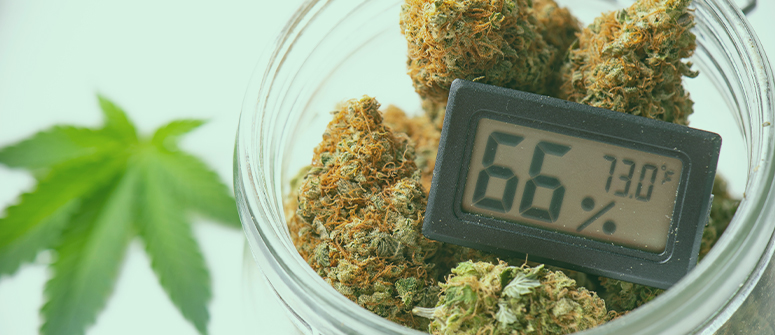
Air
Exposure to oxygen accelerates the natural breakdown of cannabinoids. However, the THC doesn't actually disappear. Instead, it's converted into the non-psychotropic cannabinoid CBN. And while CBN has its uses, it doesn’t get you high, which, for many people, is the primary reason for smoking weed. Fortunately, this conversion isn't immediate, so you don't have to panic if you leave your buds unattended for a few hours. Still, leave them exposed for days or weeks, and the difference will become very noticeable. For this reason, an airtight container is a must for maintaining bud freshness and potency.
Light
Last but by no means least is the impact of leaving your buds under direct sunlight—or, more specifically, under the degrading glare of UV rays. Doing so accelerates the breakdown of cannabinoids and terpenes, contributing heavily to those dry, dusty buds we mentioned earlier. When you're not busy grinding or rolling, buds should always be stored away from direct sunlight in an opaque container.
How to store cannabis buds
Now that you understand the ideal conditions for storing weed (and what to avoid), it's time to explore the most common storage options.
Best options to store weed
Investing in adequate storage from the get-go is essential. In fact, it's one of the few aspects of the cannabis experience you only need to do once, as several half-decent containers will keep your buds safe for years to come.
Glass and ceramic containers
Though one of the more expensive options, a glass or ceramic container is unbeatable when maintaining bud freshness. The most common choice is a glass mason jar, which manages three of the four environmental factors that affect weed.
The airtight lid will prevent exposure to oxygen, while the glass construction prevents any aroma or residue from leaching into the container. Mason jars are also large enough for you to throw in a few humidity packs, and provided you store them in a cupboard or drawer, UV exposure won't be an issue either.
Vacuum bags
Using vacuum bags is an interesting concept because, in principle, they are a great choice. Not only do they negate the risk of excessive moisture, but they can help to preserve cannabinoids and terpenes by protecting the trichomes from degradation. They're also completely odourless, so if you want your stash to stay hidden, vacuum-sealing your buds is the way to go.
However, vacuum bags aren't the most practical for everyday use, and unless you plan on storing your weed for an extended period, it's easier to use a glass mason jar. Still, vacuum bags could be your saviour if you find yourself with more buds than you can smoke in the next few months.
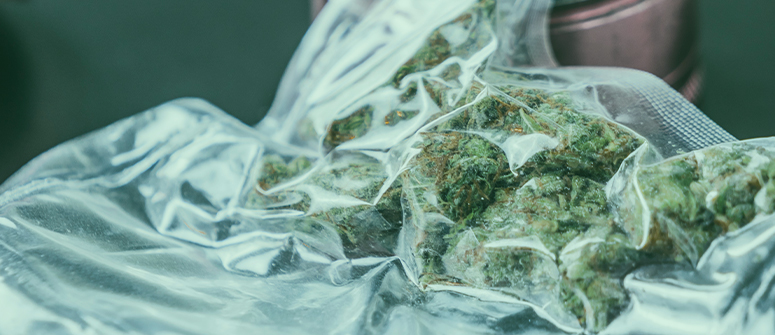
Metal containers
Metal containers are great for cannabis because they block out UV rays, are durable, and don't affect the taste of your buds. However, you need to invest in the right type of metal container. In this case, stainless steel is the way to go. Not only is it resistant to moisture, but it also works well at managing external temperature fluctuations.
Premium options like the CVault include a built-in section for a humidity pack and can double as a curing jar. Alongside glass mason jars, stainless steel containers are the go-to option for many cannabis users.
Humidor
Cannabis humidors differ slightly from the traditional humidors used to store cigars or tobacco. While they're still designed to maintain optimal relative humidity (58–62%), they are usually made from non-cedar woods. This prevents the natural infusion of the wood flavour profile into your weed—something cigar smokers prefer.
The main benefit of a cannabis humidor is that you don't need to worry about adding humidity packs to your stash—the container does the hard work for you. They're also airtight and, as they're made of solid wood, protect buds from harmful UV exposure.
If you're someone that values form alongside function, then a cannabis humidor makes for an excellent centrepiece, and certainly looks the part at social engagements.
Less optimal options to store weed
Having covered the premium options, it's time to look at less-effective methods for storing weed. You'll definitely want to avoid these in the long term, but they're still better than leaving your weed fully exposed to the elements.
Wooden box
Essentially a budget humidor, a wooden box will protect buds from air exposure and UV rays. It won't, however, manage the relative humidity for you, so you'll have to consider adding humidity packs to keep conditions optimal. You must also check the construction and wood type, as you don't want any of the wood flavour or chemicals leaching into your buds and vice versa.
Foil (short-term)
Your second short-term option for storing weed is tin foil. Although, it's best to think of this as a means for transporting weed rather than storing it. While it's possible to leave your weed inside wrapped foil, it's not the most protective of storage containers and will likely damage buds, breaking off the trichomes you're trying to preserve. Use it in a pinch, but don't rely on it to maintain long-term freshness.
No-gos for storing weed
From the best to the worst, all the methods listed below will compromise the integrity of your prized buds and should be avoided whenever possible.
Plastic bags or containers

First of all, plastic zip-lock bags offer little to no protection for your weed. This usually means that by the time you've thrown your buds into your bag and arrived at wherever you're planning to smoke, you'll find them crushed and broken.
Second, plastic zip-lock bags do not seal well, allowing air to enter and exit the bag easily. While this can cause obvious problems for anyone trying to direct attention away from their stash, it also means your buds will quickly start losing their unique aromas and flavours. Finally, zip-lock bags allow moisture to escape, meaning your buds will eventually end up dryer than the Sahara.
Freezer of refrigerator
Keeping weed in a fridge or freezer is asking for trouble. In the refrigerator, you risk excessive moisture turning your buds into a bacterial breeding ground, while your favourite cheese, fish, or leftovers taint the flavour.
The opposite is true of the freezer, where extreme temperatures can dry out buds, causing them to become brittle and harsh. Plus, when it comes time to defrost your buds, you re-run the risk of moisture turning them into a bacterial mush. With the plethora of storage options outlined above, there's never a good reason to consider using the fridge or freezer to store cannabis buds. It simply isn't worth it.
How long can you store cannabis buds?
If all that talk of mouldy buds and stinky fridges has you panicking, here’s some good news. Stored under optimal conditions (and in a suitable container), cannabis buds can easily last 6–12 months, maybe even longer.
However, there are some caveats to long-term storage. No matter how well you look after your weed, it will lose potency and some of its flavour over time. Now, the exact rate at which this happens is uncertain, but just be aware that the mind-blowing high you experienced might not hit quite as hard six months down the line. Still, provided there's no mould on your buds, don’t let the age put you off.
Storing weed? Go glass!
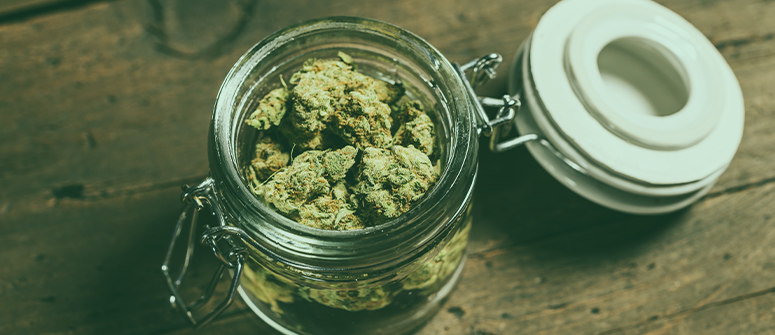
In most scenarios, glass jars are the easiest to use and the most versatile. While they may not block out damaging UV rays, storing them in a cupboard or drawer can easily overcome that issue. And the best part is you can pick up glass mason jars easily online and in most hardware stores.
Marijuana, just like tobacco and other smokable herbs, is made to be enjoyed and to maximise your enjoyment, it's vital you store your stash correctly. Follow these tips, and you'll be guaranteed a fresh smoke, no matter how quickly or slowly you go through your buds.




